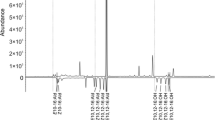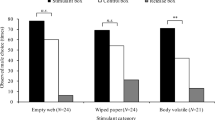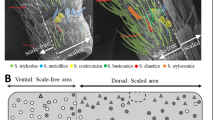Abstract
The attraction of virgin female medflies to either the natural pheromonal odor of calling males or its synthetic major components was enhanced by both intermediate and minor pheromonal components in multiple choice discrimination tests. The modification of the standard Gow rotating-trap-array, cage olfactometer to allow a single source of natural pheromonal odor to be delivered equally and simultaneously to a number of traps greatly increased trapping efficacy (64% capture rate) and ability to resolve odor preference discrimination by female flies. In olfactometer cage bioassays, responding female medflies expressed preferences in attraction to male odor augmented with either synthetic intermediate or minor components over male odor alone. In dual-choice flight-tunnel bioassays, the minor blend enhanced the attractiveness of both the natural male odor and its synthetic major components. Moreover, the minor blend, when presented together with the synthetic major components, comprised an artificial pheromonal lure competitive for the first time with the natural male odor in attraction of virgin female medflies.
Similar content being viewed by others
REFERENCES
Amoore, J. E., Forrester, J., and Buttery, R. G. 1975. Specific anosmia to 1-pyrroline: The spermous primary odor. J. Chem. Ecol. 1:299–310.
Arita, L. H., and Kaneshiro, K. Y. 1986. The dynamics of the lek system and mating success in males of the Mediterranean fruit fly, Ceratitis capitata (Wiedemann). Proc. Hawaii. Entomol. Soc. 25:39–48.
Arita, L. H., and Kaneshiro, K. Y. 1989. Sexual selection and lek behavior in the Mediterranean fruit fly, Ceratitis capitata (Diptera: Tephritidae). Pac. Sci. 43:135–143.
Back, E. A., and Pemberton, C. E. 1918. The Mediterranean fruit fly. US Department Agriculture Bulletin 640, 43 pp.
Baker, P. S., Howse, P. E., Ondarza, R. N., and Reyes, J. 1990. Field trials of synthetic sex pheromone components of the male Mediterranean fruit fly (Diptera: Tephritidae) in southern Mexico. J. Econ. Entomol. 83:2235–2245.
Baker, R., Herbert, R. H., and Grant, G. G. 1985. Isolation and identification of the sex pheromone of the Mediterranean fruit fly, Ceratitis capitata (Wied.). J. Chem. Soc., Chem. Commun. 1985:824–825.
Cunningham, R. T. 1966. Sex identification of pupae of three species of fruit flies (Diptera: Tephritidae). Ann. Entomol. Soc. Am. 59:864–865.
CossÉ, A. A., Todd, J. L., Millar, J. G., MartÍnez, L. A., and Baker, T. C. 1995. Electroantennographic and coupled gas chromatographic-electroantennographic responses of the Mediterranean fruit fly, Ceratitis capitata, to male produced volatiles and mango odor. J. Chem. Ecol. 21:1823–1836.
Epsky, N. D., Hendrichs, J., Katsoyannos, B. I., VÁsquez, L. A., Ros, J. P., ZÜmreoglu, A., Pereira, R., Bakri, A., Seewooruthun, S. I., and Heath, R. R. 1999. Field evaluation of female-targeted trapping systems for Ceratitis capitata (Diptera: Tephritidae) in seven countries. J. Econ. Entomol. 92:156–164.
FÉron, M. M. 1959. Attraction chimique du mâle de Ceratitis capitata Wied. (Dipt. Trypetidae) pour la femelle. C. R. Acad. Sci., Paris, Ser. D. 248:2403–2404.
FÉron, M. M. 1962. L'instinct de repreduction chez la mouche Mediterranéene des fruits Ceratitis capitata Wied. (Dipt. Trypetidae) Comportement sexuel-comportement de ponte. Rev. Pathol. Veg. Entomol. Agric. Fr. 41:1–129.
Flath, R. A., Jang, E. B., Light, D. M., Mon, T. R., Carvalho, L. A., Binder, R. G., and John, J. O. 1993. Volatile pheromonal emissions from the male Mediterranean fruit fly: Effects of fly age and time of day. J. Agric. Food Chem. 41:830–837.
Gothilf, S., and Galun, R. 1982. Olfactometer and trap for evaluating attractants for the Mediterranean fruit fly, Ceratitis capitata. Phytoparasitica 10:79–84.
Gow, P. L. 1954. Proteinaceous bait for the oriental fruit fly. J. Econ. Entomol. 47:153–160.
Heath, R. R., and Epsky, N. D. 1993. Recent progress of the development of attractants for monitoring the Mediterranean fruit fly and several Anastrepha species. Int. Atomic Energy Assoc. 43:463–472.
Heath, R. R., Landolt, P. J., Tumlinson, J. H., Chambers, D. L., Murphy, R. E., Doolittle, D. E., Dueben, B. D., Sivinski, J., and Calkins, C. O. 1991. Analysis, synthesis, formulation, and field testing of the three major components of male Mediterranean fruit fly pheromone. J. Chem. Ecol. 17:1925–1940.
Hendrichs, J., and Hendrichs, M. A. 1990. Mediterranean fruit fly (Diptera: Tephritidae) in nature: Location and diel pattern of feeding and other activities on fruiting and nonfruiting hosts and nonhosts. Ann. Entomol. Soc. Am. 83:632–641.
Howse, P. E. 1987. Insect attractant comprising linalool. United Kingdom Patent Applic. GB 2178315A, 4 pp.
Howse, P. E., and Knapp, J. J. 1995. Pheromones of Mediterranean fruit fly: Presumed mode of action and implications for improved trapping techniques, pp. 91–99, in B. A. McPheron and G. J. Steck (eds.). Fruit Fly Pests: A World Assessment of Their Biology and Management. St. Lucie Press, Delray Beach, Florida.
Jacobson, M., Ohinata, K., Chambers, D. L., Jones, W. A., and Fujimoto, M. S. 1973. Insect sex attractants. 13. Isolation, identification, and synthesis of sex pheromones of the male Mediterranean fruit fly. J. Med. Chem. 16:248–251.
Jang, E. B. 1995. Effects of mating and accessory gland injections on olfactory-mediated behavior in the female Mediterranean fruit fly, Ceratitis capitata. J. Insect Physiol. 41:705–710.
Jang, E. B., and Light, D. M. 1991. Behavioral responses of female oriental fruit flies to the odor of papayas at three ripeness stages in a laboratory flight tunnel (Diptera: Tephritidae). J. Insect Behav. 4:751–762.
Jang, E. B., and Light, D. M. 1996a. Attraction of female Mediterranean fruit flies to identified components of the male produced pheromone: qualitative aspects of major, intermediate, and minor components, pp. 115–121, in B. A. McPheron and G. J. Steck (eds.). Fruit Fly Pests: A World Assessment of Their Biology and Management. St. Lucie Press, Delray Beach, Florida.
Jang, E. B., and Light, D. M. 1996b. Olfactory semiochemicals of tephritids, pp. 73–90, in B. A. McPheron and G. J. Steck (eds.). Fruit Fly Pests: A World Assessment of Their Biology and Management. St. Lucie Press, Delray Beach, Florida.
Jang, E. B., and Nishijima, K. A. 1990. Identification and attractiveness of bacteria associated with Dacus dorsalis (Diptera: Tephritidae). Environ. Entomol. 19:1726–1731.
Jang, E. B., Light, D. M., Flath, R. A., Nagata, J. T., and Mon, T. R. 1989. Electroantennogram responses of the Mediterranean fruit fly, Ceratitis capitata, to identified volatile constituents from calling males. Entomol. Exp. Appl. 50:7–19.
Jang, E. B., Light, D. M., Flath, R. A., Binder, R. G., and Darvalho, L. A. 1994. Attraction of female Mediterranean fruit flies to the five major components of male produced pheromone in a laboratory flight tunnel. J. Chem. Ecol. 20:9–20.
Landolt, P. J., Heath, R. R., and Chambers, D. L. 1992. Oriented flight responses of female Mediterranean fruit flies to calling males, odor of calling males, and a synthetic pheromone blend. Entomol. Exp. Appl. 65:259–266.
Lhoste, J., and Roche, A. 1960. Organes odoriferants des mâles de Ceratitis capitata. Bull. Soc. Entomol. Fr. 65:206–209.
Light, D. M. 1995. Research needed on attractants and traps to improve medfly monitoring, pp. 266–270, in J. G. Morse, R. L. Metcalf, J. R. Carey and R. V. Dowel (eds.). The Mediterranean Fruit Fly in California: Defining Critical Research, U.C. Center for Exotic Pest Research Workshop. University of California Riverside.
Light, D. M. and Jang, E. B. 1996. Plant volatiles evoke and modulate tephritid behavior, pp. 123–133, in B. A. McPheron and G. J. Steck (eds.). Fruit Fly Pests: A World Assessment of Their Biology and management. St. Lucic Press, Delray Beach, Florida.
Linstead, R. P., Noble, E. G., and Boorman, E. J. 1933. Investigations of the olefinic acids. Part VI. The preparation of Δβ-acids. J. Chem. Soc. 1933:557–561.
Martelli, G. 1910. Alcune note intorno ai costumi ed ai della Mosca dele Arance Ceratitis capitata. Boll. Lab. Zool. Sci. Agric. Portici. 4:120–127.
McDonald, P. T. 1987. Intragroup stimulation of pheromone release by male Mediterranean fruit flies (Diptera: Tephritidae). Ann. Entomol. Soc. Am. 80:17–20.
Nakagawa, S., Steiner, L. F., and Farias, G. J. 1981. Response of virgin female Mediterranean fruit flies to live mature normal males, sterile males, and trimedlure in plastic traps. J. Econ. Entomol. 74:566–567.
Ohinata, K., Jacobson, M., Nakagawa, S., Fujimoto, M. S., and Higa, H. 1977. Mediterranean fruit fly: Laboratory and field evaluations of synthetic sex pheromones. J. Environ. Sci. Health A12:67–78.
Prokopy, R. J., and Hendrichs, J. 1979. Mating behavior of Ceratitis capitata on a field-caged host tree. Ann. Entomol. Soc. Am. 72:642–648.
Roelofs, W. L. 1978. Threshold hypothesis for pheromone perception. J. Chem. Ecol. 4:685–699.
SAS Institute. 1988. SAS User's Guide: Statistics, ver. 6.02 ed. SAS Institute, Cary, North Carolina.
Shelly, T. E., Whittier, T. S., and Kaneshiro, K. Y. 1993. Behavioral responses of Mediterranean fruit flies (Diptera: Tephritidae) to trimedlure baits: Can leks be created artifically? Ann. Entomol. Soc. Am. 86:341–351.
Shelly, T. E., Whittier, T. S., and Kaneshiro, K. Y. 1994. Sterile insect release and the natural mating system of the Mediterranean fruit flies, Ceratitis capitata (Diptera: Tephritidae). Ann. Entomol. Soc. Am. 87:470–481.
Whittier, T. S., Kaneshiro, K. Y., and Prescott, L. D. 1992. Mating behavior of Mediterranean fruit flies (Diptera: Tephritidae) in a natural environment. Ann. Entomol. Soc. Am. 85:214–218.
Whittier, T. S., Nam, F. Y., Shelly, T. E., and Kaneshiro, K. Y. 1994. Male courship success and female discrimination in the Mediterranean fruit fly (Diptera: Tephritidae). J. Insect Behav. 7:159–170.
Wong, T. T. Y., and Nakahara, L. M. 1978. Sexual development and mating response of laboratory-reared and native Mediterranean fruit flies. Ann. Entomol. Soc. Am. 71:592–596.
ZÜmreoglu, A., Ohinata, K., Fujimoto, M. S., Higa, H., and Harris, E. J. 1979. Gamma irradiation of the Mediterranean fruit fly: Effect of treatment of immature pupae in nitrogen on emergence, longevity, sterility, sexual competitiveness, mating ability, and pheromone production of males. J. Econ. Entomol. 72:173–176.
Author information
Authors and Affiliations
Rights and permissions
About this article
Cite this article
Light, D.M., Jang, E.B., Binder, R.G. et al. Minor and Intermediate Components Enhance Attraction of Female Mediterranean Fruit Flies to Natural Male Odor Pheromone and Its Synthetic Major Components. J Chem Ecol 25, 2757–2777 (1999). https://doi.org/10.1023/A:1020855625244
Issue Date:
DOI: https://doi.org/10.1023/A:1020855625244




